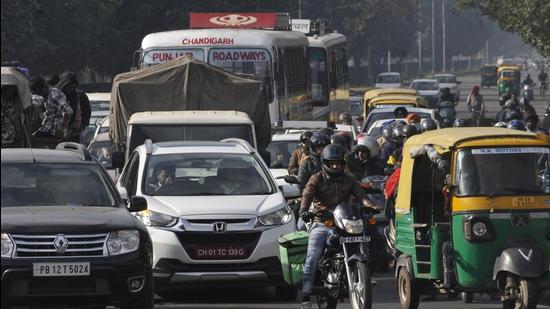RITES to prepare roadmap to decongest Chandigarh roads by August 2022
Chandigarh Mobility Plan to focus on providing safe, efficient and seamless connectivity for residents of Chandigarh
The UT administration has set the ball rolling on the Chandigarh Mobility Plan by fixing August 2022 as the deadline for Rail India Technical and Economic Services (RITES) to submit its plan for decongesting city roads.

In a meeting, chaired by UT adviser Dharam Pal to discuss the Comprehensive Mobility Plan for Chandigarh tricity area, the administration asked RITES, which will start the work in January 2022, to submit its report within eight months.
The meeting, attended by senior UT officials and representatives of RITES, was held at the UT Secretariat on Tuesday.
Pal said, “We had a preliminary meeting with RITES and fixed the timelines for the study. They will have to submit different progress reports after every two months. There will be an inception report, collection of data, presentation of draft report and presentation of final report. The entire process will have to be completed within eight months.”
In this meeting, study objectives and vision for sustainable mobility for horizon year 2041 were also highlighted.
“RITES will update the data of the its 2009 report and prepare the plan as per the latest guidelines of the Union ministry of road, transport and highways (MoRTH). It will conduct scenario analysis of different mobility options in different sectors and then submit which mass rapid transport system (MRTS) is the best suited for the tricity,” said Pal.
RITES will also offer options to integrate mobility plan with land use plan and determine the optimal mix of multi-modal public transport network.
Focus on green mobility
The focus of the mobility plan will be to provide safe, secure, efficient, reliable and seamless connectivity for residents of Chandigarh, added Pal.
In addition to this, the officials also focused on low-carbon mobility plan for the city as the key area for Chandigarh Comprehensive Mobility Plan (CMP). It was stressed that the existing transport system with current and future demands for public transport system should be kept in mind.
Notably, in November this year, the administration, in a major push to create an eco-friendly transportation in the city, accepted the United Kingdom’s offer to provide technical assistance to develop a sustainable mobility plan for the city.
The broad objective of the UK-funded study is to provide support for de-carbonising the city’s transport and contribute towards the climate change agenda. The study will also focus on suggesting alternative eco-friendly transport system for the city.
The work on this study is also set to start in January.
“Both consultants will work together. They will also examine different international options. Then they will integrate their mobility solutions. Our focus is on the green options within the comprehensive mobility plan,” said Pal.
MRTS plans revived in August this year
After years in cold storage, MRTS plans were revived in August this year by the administration after it decided to go in for a fresh study on the comprehensive mobility plan for the city.
The earlier RITES report, prepared more than a decade ago, was found to be outdated as the city’s requirements changed drastically during this period and also, the guidelines set by MoRTH of the MRTS project changed.
With a population of over 12 lakh and 15 lakh registered vehicles, Chandigarh has the highest density of vehicles per household in the country, leading to traffic congestion and snarls. In addition to these, over two lakh vehicles on interstate routes cross the city daily.
Since the metro rail plans were shelved, the administration has not been able to opt for any other alternative, such as monorail, skybus or metrolite.





